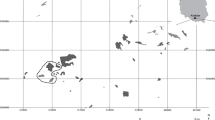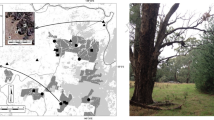Abstract
In conserving organisms, a bipolar view has generally been adopted of landscapes, in which resources are allocated to patches of habitats and the matrix ignored. Allocating additional resources to the matrix would depend on two conditions: first, that organisms search for resources in landscapes regardless of differences in vegetation types and resource availability; second, that when resources occur in the matrix they are used by species. Behavioural data linked to biotope and substrate types, on three pierid species (Pieris brassicae, P. rapae, P. napi), have been examined to explore the relationship between flight modes and resource availability. Search flight and resource use, taken as measures of resource quests, occur extensively in all biotopes and over all substrates in addition to direct linear flight, more typical of butterflies when migrating between habitat units. Resource seeking and using even exceed direct flight in some biotopes that have been regarded generally as lacking in resources for these butterflies. For example, such is the case for P. brassicae in woodland and for P. rapae in scrub. This finding supports the view for repairing the matrix and enhancing the general countryside outside habitat patches with resources increasingly being made for organisms. The proviso is that species’ requirements are adequately researched and resourced so as not to become sinks.
Similar content being viewed by others
References
Asher J, Warren M, Fox R, Harding P, Jeffcoate G, Jeffcoate S (2001) The millennium atlas of butterflies in Britain and Ireland. Oxford University Press, Oxford
Baker RR (1969) The evolution of the migratory habit in butterflies. J Anim Ecol 38:703–746
Baker RR (1978) The evolutionary ecology of animal migration. Hodder and Stoughton, London
Bayliss JL, Simonite V, Thompson S (2005) The use of probabilistic habitat suitability models for biodiversity action planning. Agric Ecosyst Environ 108:228–250
Carey PD, Manchester SJ, Firbank LG (2005) Performance of two agri-environment schemes in England: a comparison of ecological and multi-disciplinary evaluations. Agric Ecosyst Environ 108:178–188
Courtney SP (1988) Oviposition on peripheral hosts by dispersing Pieris napi (L.) (Pieridae). J Res Lepid 26:58–63
Dennis RLH (ed) (1992) The ecology of butterflies in Britain. Oxford University Press, Oxford
Dennis RLH (1993) Butterflies and climate change. Manchester University Press, Manchester
Dennis RLH (2004a) Butterfly habitats, broad-scale biotope affiliations, and structural exploitation of vegetation at finer scales: the matrix revisited. Ecol Entomol 29:744–752
Dennis RLH (2004b) Just how important are non-consumable resources as habitat components? Indications from a declining lycaenid butterfly with priority conservation status. J Insect Conserv 8:37–45
Dennis RLH (2006) What host plants does Pieris brassicae L. (Pieridae) use away from urban environments? Entomologist’s Gaz 57:205–206
Dennis RLH, Bardell P (1996) The impact of extreme weather on Great Orme populations of Hipparchia semele (Linnaeus, 1758) and Plebejus argus (Linnaeus, 1758) (Papilionoidea: Satyrinae and Lycaenidae): hindsight, inference and lost opportunities. Entomologist’s Gaz 47:211–225
Dennis RLH, Eales HT (1997) Patch occupancy in Coenonympha tullia (Lepidoptera: Satyridae): habitat quality matters as much as patch size and isolation. J Insect Conserv 1:167–176
Dennis RLH, Eales HT (1999) Probability of patch site occupancy in Coenonympha tullia (Müller) (Lepidoptera: Satryinae) determined from geographical and ecological data. Biol Conserv 87:295–301
Dennis RLH, Shreeve TG (1996) Butterflies on British and Irish offshore islands. Gem Publishing Company, Wallingford, Oxon
Dennis RLH, Shreeve TG, Van Dyck H (2003) Towards a functional resource-based concept for habitat: a butterfly biology viewpoint. Oikos 102:417–426
Dennis RLH, Hodgson JG, Grenyer R, Shreeve TG, Roy DB (2004) Host plants and butterfly biology. Do host-plant strategies drive butterfly status? Ecol Entomol 29:12–26
Dennis RLH, Shreeve TG, Isaac NJB, Roy DB, Hardy PB, Fox R, Asher J (2006a) The effects of visual apparency on bias in butterfly recording and monitoring. Biol Conserv 128:486–492
Dennis RLH, Shreeve TG, Van Dyck H (2006b) Habitats and resources: the need for a resource-based definition to conserve butterflies. Biodiv Conserv 15:1943–1968
Dennis RLH, Shreeve TG, Sheppard DA (2006c) Species conservation and landscape management: a habitat perspective. In Stewart A, Lewis O, New T (eds) Insect conservation biology. Royal Entomological Society Symposium, London, CABI, Wallingford (in press)
Dover JW (1996) Factors affecting the distribution of butterflies on arable farmland. J Appl Ecol 33:723–734
Dover JW, Sparks T, Clarke S, Gobbett K, Glossop S (2000) Linear features and butterflies: the importance of green lanes. Agric Ecosyst Environ 80:227–242
Driscoll DA (2005) Is the matrix a sea? Habitat specificity in a naturally fragmented landscape. Ecol Entomol 30:8–16
Ehrlich PR, Hanski I (eds) (2004) On the wings of checkerspots. A model system for population biology. Oxford University Press, Oxford
Field RG, Gardiner T, Mason CF, Hill J (2005) Agri-environment schemes and butterflies: the utilization of 6 m grass margins. Biodiv Conserv 14:1969–1976
Grashof-Bokdam CJ, van Langevelde F (2005) Green veining: landscape determinants of biodiversity in European agricultural landscapes. Landscape Ecol 20:417–439
Hanski IA, Gilpin ME (eds) (1997) Metapopulation biology. Ecology, genetics, and evolution. Academic Press, London
Hardy PB, Dennis RLH (1999) The impact of urban development on butterflies within a city region. Biodiv Conserv 8:1261–1279
Herzog F (2005) Agri-environment schemes as landscape experiments – preface. Agric Ecosyst Environ 108:175–177
Hirota T, Obara Y (2000) The influence of air temperature and sunlight intensity on mate-locating behavior of Pieris rapae crucivora. Zool Sci 17:1081–1087
Hodgson JG, Grime JP, Wilson PJ, Thompson K, Band SR (2005) The impacts of agricultural change on the grassland flora of Central England: process and prospects. Basic Appl Ecol 6:107–118
Kaiser L, Willis MA, Carde RT (1994) Flight manoeuvres used by a parasitic wasp to locate host-infested plant. Entomologia Ex Appl 70:285–294
Lyytinen A, Alatalo RV, Lindstrom L, Mappes J (1999) Are European white butterflies aposematic? Evol Ecol 13:709–719
Matter SF, Roland J (2002) An experimental examination of the effects of habitat quality on the dispersal and local abundance of the butterfly Parnassius smintheus. Ecol Entomol 27:308–316
Mattison EHA, Norris K (2005) Bridging the gap between agricultural policy, land use and biodiversity. Trends Ecol Evol 20:610–616
Molleman F, van Alphen ME, Brakefield PM, Zwaan BJ (2005) Preferences and food quality of fruit-feeding butterflies in Kibale Forest, Uganda. Biotropica 37:657–663
New TR (1997) Butterfly conservation, 2nd edn. Oxford University Press, Oxford
New TR (2005) Invertebrate conservation and agricultural ecosystems. Cambridge University Press, Cambridge
Omura H, Honda K (2005) Priority of color over scent during flower visitation by adult Vanessa indica butterflies. Oecologia 142:588–596
Ouin A, Aviron S, Dover J, Burel F (2004) Complementation/supplementation of resources for butterflies in agricultural landscapes. Agric Ecosyst Environ 103:473–479
Pollard E, Yates TJ (1993) Monitoring butterflies for ecology and conservation. Chapman and Hall, London
Roland J, Keyghobadi N, Fownes S (2000) Alpine Parnassius butterfly dispersal. Effects of landscape and population size. Ecology 81:1642–1653
Schulz S, Boppré M, Vane-Wright RI (1993) Specific mixtures of secretions from male scent organs of African Milkweed butterflies (Danainae). Phil Trans R Soc Lond B 342:161–181
Shreeve TG, Dennis RLH, Van Dyck H (2004) Resources, habitats and metapopulations – whither reality? Oikos 106:404–408
Spieth HR, Cordes RG, Dorka M (1998) Flight directions in the migratory butterfly Pieris brassicae: results from semi-natural experiments. Ethology 104:339–352
Srygley RB, Oliveira EG (2001) Sun compass and wind drift␣compensation in migrating butterflies. J Navig 54:405–417
Srygley RB, Kingsolver JG (1998) Red-wing blackbird reproductive behaviour and the palatability, flight performance, and morphology of temperate pierid butterflies (Colias, Pieris, and Pontia). Biol J Linn Soc 64:41–55
Statsoft (1999) STATISTICA for Windows 95/98/NT. Statsoft, Tulsa
Stjernholm F, Karlsson B (2000) Nuptial gifts and the use of body resources for reproduction in the green-veined white butterfly Pieris napi. Proc R Soc Lond B 267:807–811
Thomas JA, Bourn NAD, Clarke RT, Stewart KE, Simcox DJ, Pearman GS, Curtis R, Goodger B (2001) The quality and isolation of habitat patches both determine where butterflies persist in fragmented landscapes. Proc R Soc Lond B 268:1791–1796
Tscharntke T, Klein AM, Kruess A, Steffan-Dewenter I, Thies C (2005) Landscape perspectives on agricultural intensification and biodiversity-ecosystem service management. Ecol Lett 8:857–874
Van Dyck H, Baguette M (2005) Dispersal behaviour in fragmented landscapes: routine or special movements? Basic Appl Ecol 6:535–545
Vane-Wright RI, Boppré M (1993) Visual and chemical signaling in butterflies – functional and phylogenetic perspectives. Phil Trans R Soc Lond B 340:197–205
Acknowledgement
Our grateful thanks to John Dover and to two anonymous referees for their helpful comments.
Author information
Authors and Affiliations
Corresponding author
Rights and permissions
About this article
Cite this article
Dennis, R., Hardy, P. Support for mending the matrix: resource seeking by butterflies in apparent non-resource zones. J Insect Conserv 11, 157–168 (2007). https://doi.org/10.1007/s10841-006-9032-y
Received:
Accepted:
Published:
Issue Date:
DOI: https://doi.org/10.1007/s10841-006-9032-y




